

In the few days prior to New Year’s Eve, Healdsburg, California,
home of the Tile Heritage Foundation, we experienced multiple
rainstorms propelled by what we call “The Pineapple Express,”
fierce weather moving across the Pacific Ocean bringing warm, heavy
rains and wind to the Sonoma County Coast. We are situated on (in!)
the Russian River thirty miles from its Pacific Ocean estuary and are
affected by both the tides and the amount of water the Army Corps
elects to release from Lake Mendocino north of us, in addition, of
course, to the rainfall throughout the river valley itself. The net
result can mean flooding in the Russian River Valley where we live.
On December 31st the water inundated our lower yard to a depth of
about 4 feet but was of no imminent threat to our home or the THF
archives. However it is an amazing sight, such a volume of water
flying past us. We are humbled by the strength and beauty of Mother
Nature and our respect is palpable.
February 3, 2006. Entries for the Spectrum Awards and the Prism
Awards, as reported in last month’s “E-News.” For details on
Spectrum click on www.coverings.com/spectrum-awards-3.html and for
Prism www.coverings.com/prism-awards-3.html
February 6, 2006. Postmark date for slides, fee and entry form for
the 16th National Ceramic Competition hosted by The San Angelo Museum
of Fine Arts in San Angelo, Texas as reported in last month’s “E-
News.” For more details and an entry form click on www.samfa.org/NCC/
ncc_2006.htm.
As reported last month Kirby Brown’s lecture, California Faience of
Berkeley: A Family Perspective will be held on Thursday evening,
January 26th at The Hillside Club, 2286 Cedar Street in Berkeley. We
will be there, and we hope to see you!
“Beneath the Surface,” the SAMA conference in Chicago, March
15-19! For details: www.americanmosaics.org.
Coverings, April 4-7, in Orlando. No other event in the Americas can
claim as much tile and stone buying power in one place at one time as
Coverings!
For more information, go to www.coverings.com.
Don’t forget to set aside the dates, September 13-17, 2006 for
“Tiles of the Northern Plains: Building on Tradition” in
Minneapolis presented by the Handmade Tile Association and the Tile
Heritage Foundation. Details forthcoming.
That afternoon tile maker Laird Plumleigh took some of us on a hike
of the Torrey Pines State Reserve, north of La Jolla. But first a
tour of the new Lodge at Torrey Pines. Designed in a remarkably
authentic Arts and Crafts style, and patterned after some of Greene
and Greene’s historic Pasadena houses, the Lodge shows a respect for
Despite our informal attire we were warmly received by the hotel
staff. No doubt Laird’s familiar presence had something to do with
this; the gift shop sells his tiles! Of particular interest was the
tribute paid to Albert Valentien,
When you visit, check out the two large, tiled fireplaces in the
hotel’s parlors. Both exhibit impressive craftsmanship. If you
happen to know the maker, please let us know. Laird says they are not
his.
Torrey Pines State Reserve is located adjacent to the hotel and yet
remains one of the wildest stretches of land on the Southern
California coast. Because of the efforts and foresight of the people
in this area, 2000 acres of land are as they were before San Diego
was developed — with the chaparral plant community, the rare and
elegant Torrey Pine trees, miles of unspoiled beaches, and a lagoon
that is vital to migrating seabirds. One can imagine what California
must have looked like to the early settlers, or to the Spanish
explorers, or even to the first California residents here, the
Kumeyaay people.
In Escondido, California, within a 12-acre natural habitat, in the
Iris Sankey Arboretum in Kit Carson Park, the late Niki de Saint
Phalle (1930-2002) created a unique mosaic masterpiece, the only
American sculpture garden of its kind and the last of her major
international projects. Queen Califia’s
The garden, like the state itself, takes its name from the legendary
black Amazon queen, Califia, who was believed to rule a terrestrial
island paradise of gold and riches. Queen Califia’s Magical Circle
bears the brilliant, unique mosaic ornamentation that is an
unmistakable part of Saint Phalle’s later work. The garden uses a
greater diversity of mosaic materials than any other of her large-
scale projects. She personally selected dozens of varieties of glass
of different shapes, color, hue, translucency and degrees of
reflection. For the first time, she also used a wide assortment of
polished and
Niki de Saint Phalle was born in 1930 in Neuilly-sur-Seine, France,
and raised in New York City. She began painting in 1948, moved four
years later to Europe (Nice, Paris and Mallorca) and first came to
international prominence in 1961 as a member of the influential
Saint Phalle continued living near Paris until 1994 when, for reasons
of poor health (brought about by exposure to toxic fumes from
polyester materials used in her early sculptures), she moved to La
Jolla, California. “California has been a
Always interested in expanding the audience for contemporary art,
she
created Queen Califia as a place for families to gather,
Visit www.queencalifia.org
It was in 1868 that city leaders in San Diego set aside a 1,400-acre
tract of land for a public park. Known as simply City Park until a
contest was held in 1910, Balboa Park was named after the Spanish
conquistador, Vasco Núñez de Balboa, purportedly the first European
to see the Pacific.
The park came into its own as in 1915–1916 it became the site for
the Panama-California International Exposition, honoring the
completion of the Panama Canal. The purpose of the Expo was "to
illustrate the progress and possibility of the human race...."
Displays and demonstrations included the latest in agricultural,
industrial, horticultural, and technological inventions and refinements.
The Spanish Colonial Revival style of architecture prevailed in the
exposition’s buildings that were designed by the well-known
architect Bertram Grosvenor
As a way of bolstering the local economy in the midst of the Great
Depression,
Alcazar Garden, named because its design is patterned after the
gardens of Alcazar Castle in Seville, Spain, is directly across El
Prado from the California
Working with officials of the City of San Diego, Balboa Park, Estrada
Land Planning and Soltec Construction, Laird Plumleigh designed,
sculpted and finished the ceramic cladding that now adorns the Plaza
de Panama Fountain in Balboa Park. The patterns and colors in the
tile work were designed in Hispano-Moresque style to be consistent
with the cultural surroundings of Balboa Park. Located in the center
of the park on El Prado in front of the San Diego Museum of Art, the
fountain is identified as an important part of the restoration of
Plaza de Panama to its historic role as a pedestrian-oriented, paved
and landscaped area.
Edith Heath, a leading ceramist of mid-century modern designs, known
for her tableware and architectural tiles, died at her home in
Tiburon, California on December 27, 2005. She was 94. According to Bill Stern, executive director of the Museum of
California Design in Los Angeles, “Edith was at the forefront of the
move to modernist design that influenced architecture and furniture
as well as ceramics.”
The movement began in the 1930s and grew
stronger in the ’40s. She was known for creating simple shapes
inspired by Japanese tableware. Through most of her career she worked
on a commercial scale but achieved a level of artistry generally
associated with handcrafted work.
Edith began her design career making pots. Her first museum exhibit
was at the Palace of the Legion of Honor in San Francisco in 1944.
Her designs and tableware were sold in specialty stores throughout
the United States.
In 1967 the architectural company of Ladd & Kelsey, which designed
the Pasadena Art Museum (now the Norton Simon Museum), asked Heath to
create architectural tiles for the building’s exterior, for which
she received the Industrial Arts Medal from the American Institute of
Architects. Among the other prestigious tile installations: Ford
Foundation, New York; Mauna Kea Hotel, Hawaii; Security Pacific Bank,
Los Angeles; Bank of America, San Jose; New Bank of China, Hong Kong;
numerous Nordstrom stores; Yerba Buena Center, San Francisco.
Edith remained active through her 80s, selling her business, Heath
Ceramics, Sausalito, California in 2003. The new owners continue to
produce her original designs. Visit www.heathceramics.com.
Information taken partially from “Obituaries” in the Los Angeles
Times and from
(Available each month to Tile Heritage members who e-mail the Foundation from the address they
would like
E-News sent to. Contact: foundation@tileheritage.org)
PRINTED VERSION


Here’s What’s Below:
Happy (and wet) New Year!
Important Deadlines
Upcoming Events
San Diego: A Good Mix
Mosaic Magic: Niki de Saint Phalle
Balboa Park: Reflecting an Earlier Era
A Legend Lost: Edith Heath
Recipe for Relief


New Year’s Eve:
A Time to Pull on Our “Wellies”

Important
Deadlines
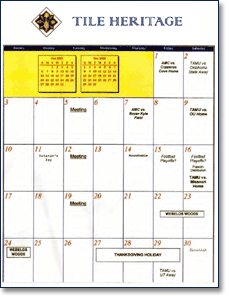
Reminder
of Upcoming Events
 San Diego:
A Good Mix of Business and Pleasure.
San Diego:
A Good Mix of Business and Pleasure.

On December 16th Tile Heritage held its 4th quarter board meeting in
Solana Beach, California (north of San Diego) at the home of board
member Irene de Watteville. In honor of the presence of the entire
board Irene arranged and hosted a wonderful evening party inviting
local THF members, tile makers, tile artisans and mosaicists to her
home, resulting in a wonderful (the neighbors would say “wild”)
celebration of good food, wine, music and dance while overlooking the
Pacific Ocean.

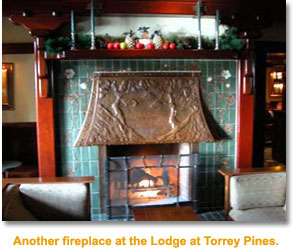 history that’s rare on the prefabricated Southern California
coastline. And all the more impressive is the fact that despite the
century-old look, it’s brand new; this hotel was completed in 2002,
and hewed strictly to traditional tongue and groove methods of
craftsmanship, as well as modern building regulations.
history that’s rare on the prefabricated Southern California
coastline. And all the more impressive is the fact that despite the
century-old look, it’s brand new; this hotel was completed in 2002,
and hewed strictly to traditional tongue and groove methods of
craftsmanship, as well as modern building regulations.
 Rookwood ceramist turned wildflower
illustrator, who moved to the San Diego area at the beginning of the
20th century. In addition to the hotel’s restaurant named after him,
there is a small, handsome display case that contains samples of his
ceramic work.
Rookwood ceramist turned wildflower
illustrator, who moved to the San Diego area at the beginning of the
20th century. In addition to the hotel’s restaurant named after him,
there is a small, handsome display case that contains samples of his
ceramic work.

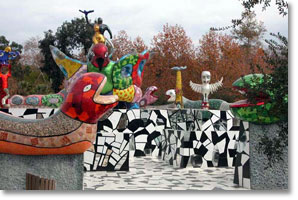
Mosaic Magic:
Niki de Saint Phalle
 Magical Circle, inspired by
California’s mythic, historic and cultural roots, measures 120 feet
in diameter and consists of nine large-scale sculptures, a circular,
400-foot “snake” wall and maze entryway, sculpturally integrated
bench seating, an egg-shaped fountain and native shrubs and trees
planted within the interior plaza and along the outer perimeter. The
garden opened to the public on October 26, 2003.
Magical Circle, inspired by
California’s mythic, historic and cultural roots, measures 120 feet
in diameter and consists of nine large-scale sculptures, a circular,
400-foot “snake” wall and maze entryway, sculpturally integrated
bench seating, an egg-shaped fountain and native shrubs and trees
planted within the interior plaza and along the outer perimeter. The
garden opened to the public on October 26, 2003.

 tumbled stones such as travertine, agates, quartzes and
veined turquoise. The results are magical and ever changing, as the
movement of light, wind, color and reflections continually transform
the garden.
tumbled stones such as travertine, agates, quartzes and
veined turquoise. The results are magical and ever changing, as the
movement of light, wind, color and reflections continually transform
the garden.
 “New Realists,” a group that also included Christo, Yves Klein and Jean
Tinguely (her frequent collaborator whom she married in 1971). Today,
she is best known for her oversized, voluptuous female figures, the
Nanas, which can be seen in cities and museums around the world.
Among her large-scale installations are The Stravinsky Fountain near
the Centre Pompidou in Paris (1983), The Tarot Garden at Garavicchio
in southern Tuscany (which was entirely financed by the artist and
opened after twenty-four years of work in 1998) and The Grotto in
Hannover’s Royal Herrenhausen Garden (2003).
“New Realists,” a group that also included Christo, Yves Klein and Jean
Tinguely (her frequent collaborator whom she married in 1971). Today,
she is best known for her oversized, voluptuous female figures, the
Nanas, which can be seen in cities and museums around the world.
Among her large-scale installations are The Stravinsky Fountain near
the Centre Pompidou in Paris (1983), The Tarot Garden at Garavicchio
in southern Tuscany (which was entirely financed by the artist and
opened after twenty-four years of work in 1998) and The Grotto in
Hannover’s Royal Herrenhausen Garden (2003).

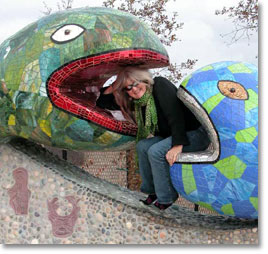 rebirth for my soul and an
earthquake for my eyes—sea, desert, mountains, wide open sky,
brilliance of light and vastness of space,” she once remarked. “I
have embraced another way of life, and have let my discovery of this
landscape manifest itself in my work.”
rebirth for my soul and an
earthquake for my eyes—sea, desert, mountains, wide open sky,
brilliance of light and vastness of space,” she once remarked. “I
have embraced another way of life, and have let my discovery of this
landscape manifest itself in my work.”
 play and
engage with a visually rich world of ideas, symbols, and forms. “My
first really big piece for kids was the Golem [completed in 1970 in
Jerusalem] and three generations know and love it.
Here [in Escondido], you can also touch the sculptures,” Saint Phalle said in
one of her last interviews. “They feel nice and you won’t harm
them. You can be a part of them ... it’s like a marriage between the
sculptures and the child or adult. Maybe it brings out the child in
adults, too.”
play and
engage with a visually rich world of ideas, symbols, and forms. “My
first really big piece for kids was the Golem [completed in 1970 in
Jerusalem] and three generations know and love it.
Here [in Escondido], you can also touch the sculptures,” Saint Phalle said in
one of her last interviews. “They feel nice and you won’t harm
them. You can be a part of them ... it’s like a marriage between the
sculptures and the child or adult. Maybe it brings out the child in
adults, too.”
for additional details.

Balboa Park:
Reflecting an Earlier Era

 Goodhue of New York. Among those still
standing is the California Building (now the Museum of Man), where
you will find brightly-colored, decorative tiles produced by
California China Products Company of National City. This
installation, along with the one at the San Diego Railroad Depot, is
historically among the most important in the state.
Goodhue of New York. Among those still
standing is the California Building (now the Museum of Man), where
you will find brightly-colored, decorative tiles produced by
California China Products Company of National City. This
installation, along with the one at the San Diego Railroad Depot, is
historically among the most important in the state.
 San Diego held the California-Pacific International
Exposition in the Park in 1935-36. The expo’s architect, Richard
Requa, designed buildings inspired by the native architecture of the
Southwest—the Indian pueblos as well as the earlier Aztec and Mayan
structures in Yucatan and Mexico.
San Diego held the California-Pacific International
Exposition in the Park in 1935-36. The expo’s architect, Richard
Requa, designed buildings inspired by the native architecture of the
Southwest—the Indian pueblos as well as the earlier Aztec and Mayan
structures in Yucatan and Mexico.
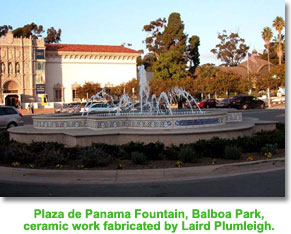 Building. It is known for its ornate
fountains, exquisite turquoise blue, yellow, and green Moorish-style
tiles and shady pergola. The tiles were produced by D. & M. Tile
Company of Los Angeles. Today, the garden has been reconstructed to
replicate Requa’s 1935 design.
Building. It is known for its ornate
fountains, exquisite turquoise blue, yellow, and green Moorish-style
tiles and shady pergola. The tiles were produced by D. & M. Tile
Company of Los Angeles. Today, the garden has been reconstructed to
replicate Requa’s 1935 design.
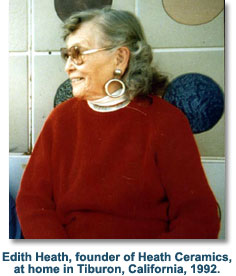
A Legend Lost:
Edith Heath


Flash Point, vol. 6, no. 1, “One With Her
Environment” by Genene M. Grimm.
Recipe
for Relief
 Wash your hands well with warm water and apply a tablespoon of apple
cider vinegar to your palms, rub well and dry off your hands.
Wash your hands well with warm water and apply a tablespoon of apple
cider vinegar to your palms, rub well and dry off your hands.